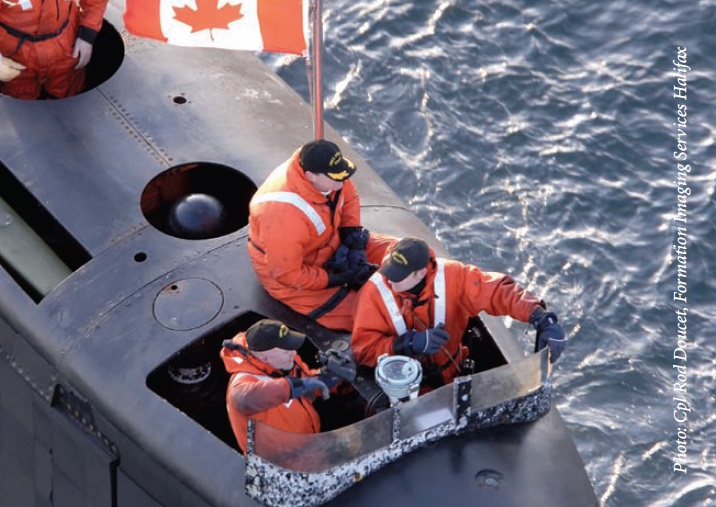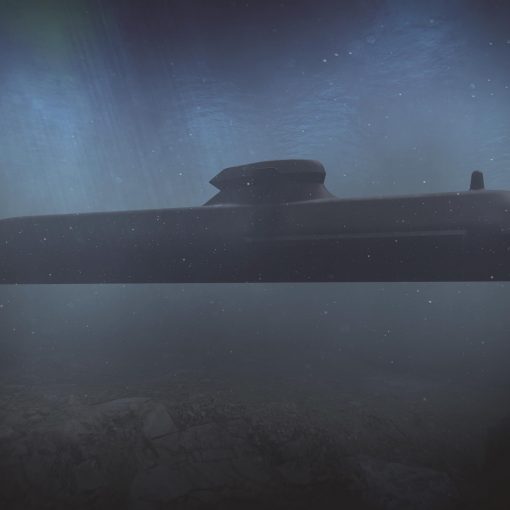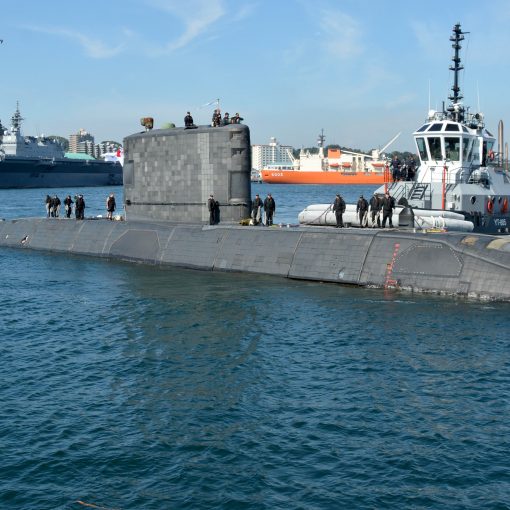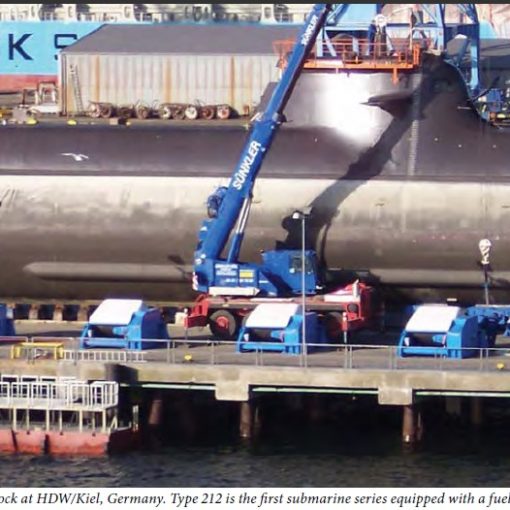David Dunlop, 1 October 2018.
The characteristics of modern 21st century submarines are: endurance, stealth, freedom of movement and versatility. The best sensor weapon that gives others pause is, without question, another submarine. If Canada does not invest in a modern submarine capability, its navy will be unable to patrol its three oceans. The larger question to answer is: Why are replacement submarines not included in Canada’s National Shipbuilding Strategy?
Only systems that can reach under the ice can tell us who else might be operating there. This requires blunt discussions with all Canadians about propulsion systems for a modern submarine that must operate in the world’s most hostile and unforgiving maritime environments. The Victoria-class does not possess an extensive under-ice capability, making them ineffective in Canada’s Arctic. The conversation about this looming capability loss needs to start now. Canada’s recent defence policy reiterated the need for Canada’s Navy to be comprised of a balanced fleet of platforms which includes submarines. Clearly, in this policy, the government has acknowledged the unique qualities and options a submarine capability brings to our national defence, and the pressing need to maintain this capability. A modern submarine designed to meet Canadian requirements must have the ability to operate in all three of our oceans without restriction and have a vigorous under-ice capability, with long endurance (including crew habitability considerations).
The Canadian Nuclear-powered (SSN) Option
Currently there is only one type of air-independent propulsion that can regenerate the atmosphere necessary for prolonged submerged operations – that is nuclear propulsion. The nuclear infrastructure surrounding this option however, is not attainable at this time due to Canadian fiscal constraints. That assessment has most assuredly not changed over the last three decades and will not change unless Canada decides to increase defence spending to at least 2% of GDP in the near future.
It boils down to one question: Can a current conventionally powered modern diesel-electric (SSK) submarine with air-independent propulsion (AIP) technologies, substitute for an SSN powered submarine to defend Canada’s future maritime security? The answer is definitely no; at least not for the foreseeable future. The logic that a Canadian SSN fleet would be a force-multiplier, meet Canadian maritime military requirements and be an ideal solution to assert our sovereignty, has definite merit and should be seriously considered as replacements for our Victoria-class SSKs.
The Canadian public is more intelligent than most ‘nay-sayers’ would give them credit for. They realize that there is nothing to fear from acquiring an SSN capability. Canadian submarines will need to operate for prolonged periods, at great distances, with unlimited endurance in some of the most unforgiving waters on the planet. The Arctic’s under-ice environment has limited opportunities for any conventional AIP-powered submarine, which lack endurance, speed, versatility and the ability to safely surface in extreme conditions.
Only SSNs have the power to repeatedly surface, even through several feet of ice. Conventional submarines are restricted to near ice-edge operations. To replenish air, SSKs must surface, or almost surface, raising their snorkel mast at regular intervals; impossible to do under all but the thinnest layers of ice. A look at the four non-nuclear AIP systems currently in service or under development show these clear limitations. (For a discussion of these systems, see the article by Norman Jolin, "Future Canadian Submarine Capability: Some Considerations," in CNR, Volume 11, No. 1 (2015).) The modern AIP record for a submerged transit is 18 days at most. An AIP propulsion system that can provide power endurance comparable to a nuclear power plant, has yet to develop. This is not to say it cannot be done, just that it has not yet materialized. It will take decades more research and developmental technology by Canada, with commensurate investments in infrastructure and training, before these AIP SSKs can favorably compare to the prolonged under-ice operations of any SSN. This is time that Canada just does not have.
Declaring the operation of Canadian SSNs within Canadian waters along Northwest Passage choke points, indicates that Canada has the capability to control and provide a respectable presence in all three of our oceans. Our Water Space Management (WSM) system, would clearly demonstrate to others that Canada has the will and the capacity to assert its own sovereignty and security in all of our WSM regions. This sovereignty, will become more important as global warming allows increased exploration of the Arctic seabed, and its rich resources. The WSM system is an important tool in this endeavour, but only if Canada maintains a viable submarine fleet which, by necessity, demands the timely replacement of our ‘ice-edge limited’" Victoria-class, with a fleet of 12 modern under-ice capable SSNs. Existing AIP technologies from Germany, France or Japan, do not meet Canadian geographical demands now or in the foreseeable future for extended safe under-ice operations.
An SSN can travel the Northwest Passage, under ice-caps, from the Atlantic to Pacific in just 14 days vice over a month via the Panama Canal. Without SSNs, Canada cannot exercise authority in its waters within the confines of our own sovereign territory. This is a central requirement to any definition of national sovereignty. The issue is not simply a matter of security, but whether Canada has the tools to provide that security. To allow the US Navy to continue providing Arctic security on our behalf, invariably will weaken Canada’s claims to its northern waters and would be incompatible with the responsibilities that Canada has as an independent state. Past Defence Minister, Warren Beatty said: "We can be judged sovereign, to the degree to which in the context of alliance and collective defence, we can contribute to our own national security. A nation that ‘contracts out’ the security and defence of its own territory is not sovereign, but a protectorate." An annual Defence budget increase of 2% of GDP, will allow Canada to easily fund an SSN acquisition programme and finally contribute meaningfully to the NATO alliance. A Canadian SSN will do more than just support Canada’s claims to its Arctic territories. It will provide Canada with a degree of credibility that well over three decades of neglect have eroded. Canadian SSNs, will give Canada a truly balanced fleet we have been sorely missing, and pull the RCN back from the abyss within NATO.
The Modern Conventional Submarine Option
Canadian-built modern submarines will require a large ocean-going non-nuclear-powered submarine that can patrol off the coasts of Canada, with prolonged forays into the Arctic, and be able to deploy worldwide either independently, or as part of a coalition force. Flexibility for fitting future equipment changes and habitability requirements must be considered in any design. This drives a modern ocean-going conventionally-powered submarine to a displacement of at least 4000-5000 tons. The issue with growth is tied directly to power generation and submerged endurance. The bigger and more capable the submarine, the more power is needed to be generated to operate efficiently. But does this submarine exist?
The different forms of non-nuclear AIP, all of which require additional types of fuel, are exclusively developed by, and for, European nations with very different submarine operating areas than Canada. Notably, they are all much closer to sources of resupply than Canadian submarines conducting domestic operations. Moreover, these systems are not powerful enough to generate and clear the atmosphere of the submarine should there be incidents on board, and therefore, at their current level of technology, are unsuitable for prolonged under-ice operations.
A modern Canadian conventional submarine designed today must see a continued refinement of diesel generation technology, greater power and fuel efficiency and accompanied by better battery technology, such as lithium. This would allow increased energy storage capacity, as well as a potential for augmentation of an AIP source for unlimited submerged power generation. In short, Canada needs to develop technology that will mirror nuclear propulsion, but not be nuclear. This will require a significant financial investment. Other navies have already invested in nuclear propulsion infrastructure, so there can be no expectation of the technological investment required to meet this challenge, to come from these nations. We need to look to Canadian industry for a solution, and push for acceptable alternatives to fossil fuels that will cause a technological revolution in power, particularly in battery technology. Is this technology there today? No, not yet, but if Canada is to obtain the submarine it requires, without embarking on huge technological investment, it needs time for Canadian industry to develop the solution.
The requirement to freely operate in the Arctic is well recognized and, there are significant challenges to achieving more than seasonal ice edge forays when operating non-nuclear powered submarines. Canadian technology will be a necessary catalyst to push the type of submarine requirements that will be considered in future submarine replacements. To answer the question: Does this conventional submarine exist? The answer is not just yet, but it could, in the very near future. The question then becomes: Can Canada build a non-nuclear modern AIP submarine? Yes, but ...the last time Canada built submarines was during the First World War for Britain. There is a compelling argument that with the assistance of an experienced submarine shipbuilder, Canada can produce a fleet of 12 modern AIP-equipped submarines, with extensive under-ice capabilities as recommended by the recent Senate Report on National Security and Defence.
The United States is arguably building the finest ocean-going nuclear submarines in the world. However, they do not build submarines for foreign states, and their submarine yards are currently fully engaged with Virginia-class SSNs and the new Columbia-class SSBNs. Moreover, politically, there is no appetite in the United States to build non-nuclear-powered submarines. The UK has one submarine yard, which is at maximum capacity to build the Astute-class SSNs and replacements for their Dreadnought-class SSBNs. Germany is the largest conventional submarine builder in the world, however designs are typically under 2000 tons and suited only for European littoral states.
France is producing a 4000+ton non-nuclear powered version of their Suffren-class SSN called the Short-Fin Barracuda-Block 1A for Australia. Japan has designed and produced the Soryu-class submarine; a very large 4200+ ton AIP conventional submarine. There are a number of shipbuilders that are very capable of designing and building Canadian submarines, but almost all are European and have little expertise with larger ocean-going designs that have become the purview of the nuclear-powered submarine community.
It is important for Canada to pay close attention to the Australian experience, as its submarine requirements mirror those of Canada. Australia has selected a long-range variant of the French Short Fin Barracuda Block 1A design, fitted with a USN combat system, to replace the Collins-class with 12 of these conventional submarines (several follow-on Australian Barracuda-class may be nuclear powered). Australia will be gearing up this year to surpass its 2% GDP threshold for its defence needs, and still has the capacity to acquire this new submarine fleet. The Australians are pushing extant technology to produce a modern conventional submarine, supported by a unique AIP system.
This is certainly unconventional in approach, but will this be the right solution for Canada? Only time will tell. It is reasonable to assume that a built-in-Canada solution, supported by a foreign shipbuilder with submarine building expertise, would be most likely. In addition to building these submarines, the necessary infrastructure, particularly the supply chain, must be in place in order to support these submarines throughout their service life from project inception to initial operation capability. A submarine replacement project will reap rewards in evolving technology as well as leverage domestic capability arising from the National Shipbuilding Strategy. However, if Canada were to instead procure an ‘off the shelf’ solution, and fail to address unique Canadian environmental requirements, these submarines will struggle to maximize their return on any significant investment.
Conclusion
There is no doubt that Canada’s beleaguered submarine capability is in great peril, and could soon die a thousand deaths. There is no denying current Defence Department fiscal constraints, but also no denying that permanently mothballing our submarine capability would be a major catastrophe and a critical mistake no matter which future government is in power. Canada’s allies have all agreed that a credible submarine capability brings with it enhanced flexibility to conduct military operations and the ability to collaborate with other allied states.
The Canadian government may have sorely misled Canadians into believing that ‘being back,’ as our Prime Minister has said, within the NATO umbrella, means Canada will be participating in UN peacekeeping and peace support operations in a much more meaningful way. If this is correct, then acquiring a strategic submarine fleet, no matter what propulsion plant is used, will be essential to this policy. The Canadian government must step up to the plate and commence the procurement process before the end of 2018 in order to judiciously acquire 12 new modern submarines for the RCN to carry out future government missions that all Canadians expect of it.
An annual defence budget increase of at least 2% of GDP, as proposed by the House of Commons Standing Committee on National Defence, will give the government the resources needed to build these submarines sooner rather than later, and allow Canada to easily fund an SSN/SSK acquisition programme, finally giving Canada the ability to contribute our ‘fair share’ within NATO. A modern 12 submarine fleet replacement of the Victoria-class, with a commensurate increase in submariner strength, would then not only be possible, but any of these built-in-Canada designs either under construction or development, could be easily acquired and would be a transformative change for our country. There would be no negative effects on Canada’s defence needs in the future, or on Canada’s strong social economy. The ability to deploy its submarine forces at home or abroad from bases in Halifax or Esquimalt, has considerable appeal to a country that wishes to renew its NATO presence. Canada must seriously re-examine the concept of a Canadian SSN submarine programme. The time for such a re-examination is now.
So long as the government of the day and military leadership remain willing to accept that Canada’s future strategic, political and military options will not be unnecessarily reduced by the absence of a credible submarine capability, Canada will never live up to its full potential as an influential global middle power. It is time for our Prime Minister to clearly state the government’s intentions with respect to the future of Canada’s submarine fleet and begin the process of replacing the Victoria-class with a modern, credible, SSN/SSK capability. To accomplish this under current fiscal constraints, would be difficult at best. The Victoria-class fleet must be utilized for several years longer, well past 2030 and well beyond their shelf-life, before modern submarines can be secured, unless an increase in defence spending is realized soon.






3 thoughts on “The Case for Canadian Submarines”
Hi again here, David. Don’t you remember how the United States killed the nuclear Canada-class project back in the ’80s? They won’t tolerate another nuclear submarine fleet in the Americas north of the equator — ever. We’d better start thinking about a good European or Japanese AIP sub and see how to adapt it for Arctic ops. That’s all we’re going to have and I wouldn’t hold my breath for the time being, as much as I hate it.
Tony: It’s sad to say that I could not agree with you more. I had to however give the SSN option a shot anyway. I strongly believe that a submarine replacement such as the French AIP Barracuda class Block 1A that is being built for Australia would be a great option for Canada in the future. With better Canadian Lithium Battery Technology will certainly help the cause for this sub. Cheers!
Perhaps purchasing refurbished Los Angeles class SSN’s?